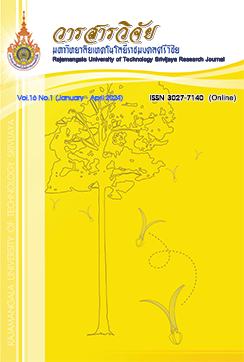Isolation and Screening of Antagonistic Bacteria for Inhibition of Pathogenic Fungi in Rice
Keywords:
antagonistic bacteria, Rhizoctonia solani, Bipolaris oryzae, Pyricularia griseaAbstract
This study aims to isolate soil bacteria from rice fields and to determine antifungal activity of the isolates. Ten soil samples were collected in Bang Len district areas areas: Lam Pa Ya, Bang Sai Pa, Nil Phet, Sai Ngam and Bua Pak Tha subdistricts, and were cross streaked on Tryptic soy agar (TSA) medium. A total of 112 bacteria was isolated. Dual-culture antagonistic tests were conducted for all bacterial isolates against rice pathogenic fungi on PDA medium at 28°C for 5 days. The findings showed that only 3 isolates, namely N5-5, G4-1 and G5-5, had antifungal activities against Rhizoctonia solani, and only 4 isolates, namely N1-1, N5-5, G4-1 and G5-5, had antifungal activities against Bipolaris oryzae. However, all isolates had no antifungal activity against Pyricularia grisea. Selected bacteria were cultured in nutrient broth medium for 18 hours, and cell turbidity was adjusted OD 600 nm to 0.5 (108cell/ml), added 1% inoculum in NB medium and incubated at room temperature (25-30oC) at 200 rpm shaking rate for 48 hours. The cells were centrifuged at 12000 rpm at 4oC for 2 min. The supernatant was added to the PDA medium at a ratio of 2:18. The antifungal activities were measured as the mean colony diameter for growth inhibition. One of the isolates (G4-1) had a moderate level of antifungal activity against R. solani at 54.29%, whereas the isolated N5-5 had the moderate level of antifungal activity against B. oryzae at 55.55%. Next, the optimization of antifungal production was studied in an NB medium at pH 3, 5, 7 and 9, respectively, and shaked at 200 rpm at 25, 30, 35 and 40°C for 48 hours. Results demonstrated that the isolated G5-5 cultured at pH 5 and 25°C had a very high level of antifungal activity against R. solani at 85.33% and B. oryzae at 66.94%. The morphological study of antagonistic bacteria G5-5 showed that it was a gram-positive rod with single and linear cell arrangement and endospore development. Therefore, we suggest that the antagonistic bacterium belongs to the genus Bacillus.
References
Bunpiak, S., Sudta, W., Issarachot, O. and Kitsanapun, A. 2019. Rice farmers’ behavior in pesticides spraying at Naraphirom subdistrict, Banglen district, Nakhon Pathom province. Journal of Safety and Health 12(3): 49-59. (in Thai)
Donmez, M.F., Uysal, B., Demirci, E., Ercisli, S. and Cakmakci, R. 2015. Biological control of root rot disease caused by Rhizoctonia solani Kühn on potato and bean using antagonist bacteria. Acta Scientiarum Polonorum Hortorum Cultus 14(5): 29-40.
Montealegre, J., Reyes, R., Pérez, L.M., Herrera, R., Silva, P. and Besoain, X. 2003. Selection of bio antagonistic bacteria to be used in biological control of Rhizoctonia solani in tomato. Electronic Journal of Biotechnology 6(2): 115-127.
Nicholson, W.L., Munakata, N., Horneck, G., Melosh, H.J. and Setlow, P. 2000. Resistance of Bacillus endospores to extreme terrestrial and extraterrestrial environments. Microbiology and Molecular Biology Reviews 64(3): 548-72.
Nochai, S. and Srichuwong, S. 2007. Efficacies of antagonistic fungi from rice seeds cv. KDML 105 for controlling bakanae disease in rice seedling. Journal of Agriculture 23(1): 59-65. (in Thai)
Pattanawipas, P., Thasakorn, T., Pasabutr, T., Lapbrunjoob, S. and Chanmuang, O. 2011. Select and test of biological control for Rhizoctonia. solani, pp. 637-643. In The annual research report 2011, The Office of Plant Protection Research. Department of Agriculture, Bangkok. (in Thai)
Petsuriyawong, B., Khunajakr, N. and Wongwicharn, A. 2012. Isolation and identification of antifungal bacteria from soil, pp. 124-131. In Proceedings of 50th Kasetsart University Annual Conference. Natural Resources and Environment, Kasetsart University, Bangkok. (in Thai)
Pimsirikul, P., Jindaprasert, K., Seesanong, S. and Phopan, A. 2016. Determination of microbial population in soil of organic vegetable farming systems. King Mongkut's Agricultural Journal 4(2): 77-84. (in Thai)
Ramachandra, N.M., Akila, R. and Thiruvudainambi, S. 2016. Management approaches for brown spot of rice caused by Bipolaris oryzae. Journal of Farm Science 29(3): 370-376.
Rajasekar, G., Ebenezar, E.G., Thiruvudainambi, S., Vanniarajan C. and Shanthi M. 2009. Antifungal activity of rice associated phyllosphere (RAP) communities against brown spot of rice (Bipolaris oryzae). Journal of Pharmacognosy and Phytochemistry 8(6): 171-175.
Tayuan, C., Rachaisawan, K. and Sriphadet, S. 2016. Control of Pyricularia grisea causing of rice blast disease. Khon Kaen Agriculture Journal 44(Suppl.I): 972-976. (in Thai)
Thapanapongworakul, P. and Saimongkol, S. 2015. Efficiency of antagonistic bacterium Bacillus megaterium strain No.16 for controlling sheath blight disease of RD6 rice variety. Agricultural Journal 31(3): 301-310. (in Thai)
Thai rice exporters association. 2021. Daily news summary 27 October – 2 November 2021. Available Source: http://www.thairiceexporters.or.th/mk_rpt/2021/news_3NOV2021XmDxIpoe.pdf, November 6, 2021. (in Thai)
Thaisuchart, H. and Boonkon, P. 2014. In vitro control of fungal contamination in stored garlic by herbal extracts and microbial antagonists. KKU Science Journal 42(4): 771-780. (in Thai)
Tipsing, S., Panvilai, S., Prajanban, J. and Meidong, R. 2019. Efficiency of Bacillus spp. from ant-hill soils against Pestalotiopsis sp. causing fruit rot disease in guava. Veridian E-Journal 6(2): 1-14. (in Thai)
Wongcharoen, A. 2013. Effect of fungicides on the growth of rice pathogenic fungi. Khon Kaen Agriculture Journal 41(Suppl.I): 527-531. (in Thai)
Downloads
Published
How to Cite
Issue
Section
License
Copyright (c) 2024 Rajamangala University of Technology Srivijaya Research Journal

This work is licensed under a Creative Commons Attribution-NonCommercial-NoDerivatives 4.0 International License.
The content and information in the article published in Journal of Rajamangala University of Technology Srivijaya It is the opinion and responsibility of the author of the article. The editorial journals do not need to agree. Or share any responsibility.







